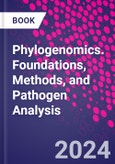Phylogenomics: Foundations, Methods, and Pathogen Analysis offers a deep overview of phylogenomics as a field, compelling recent developments, and detailed methods and approaches for conducting new research. Early chapters introduce phylogenomic analysis of viruses and bacteria, deciphering bacterial outbreaks, and evolution of drug resistance and virulence, with a second section on methods offering instruction in tools for SNP calling and dealing with big datasets, use of Bayesian approach in molecular epidemiology, bacterial evolution modeling and evolutionary reconstruction in the presence of mosaic sequences. Part 3 offers various examples of phylogenomic analysis across medically significant bacteria and viruses, including Yersinia pestis, Salmonella, Mycobacterium tuberculosis, HIV-1, measles virus as well as ancient pathogens research.
Please Note: This is an On Demand product, delivery may take up to 11 working days after payment has been received.
Table of Contents
PART I. GENERAL TOPICS AND FOUNDATIONS
1. Phylogenomic analysis and the origin and early evolution of viruses
2. Application of Next Generation Sequencing for Genetic and Phenotypic Studies of Bacteria
3. Genomic insight into deciphering bacterial outbreaks
4. Drug resistance in bacteria, molecular mechanisms and evolution
5. Virulence evolution of bacterial species
PART II. METHODS IN THE PHYLOGENOMICS
6. Modeling evolutionary changes of k-mer patterns of bacterial genomes
7. Clock Rates and Bayesian Evaluation of Temporal Signal
8. Microbial evolutionary reconstruction in the presence of mosaic sequences
9. Tools for SNP calling and the way to deal with big datasets
PART III. PHYLOGENOMICS OF SPECIFIC PATHOGENS
10. Phylogenomics of Yersinia pestis
11. Salmonella Phylogenomics
12. The phylogenomics of Shigella spp.
13. Phylogenomic diversity within Corynebacterium diphtheriae, a re-emerging threat to global public health
14. Phylogenomics of the East Asian lineage of Mycobacterium tuberculosis
15. Mycobacterium kansasii
16. Taxonomy and phylogenomics of Leptospira
17. Phylogenomics and evolution of Measles virus
18. Phylogenomics of HIV-1
19. Respiratory syncytial virus
20. Phylogenomics of Flaviviruses
21. How clonal is Staphylococcus aureus?
22. Genomic research of ancient pathogens in Central Asia
23. Subspecific nomenclature of the Cryptococcus neoformans/gattii complex and the predominant clonal evolution (PCE) model
24. Phylogenomics of Mycobacterium leprae








